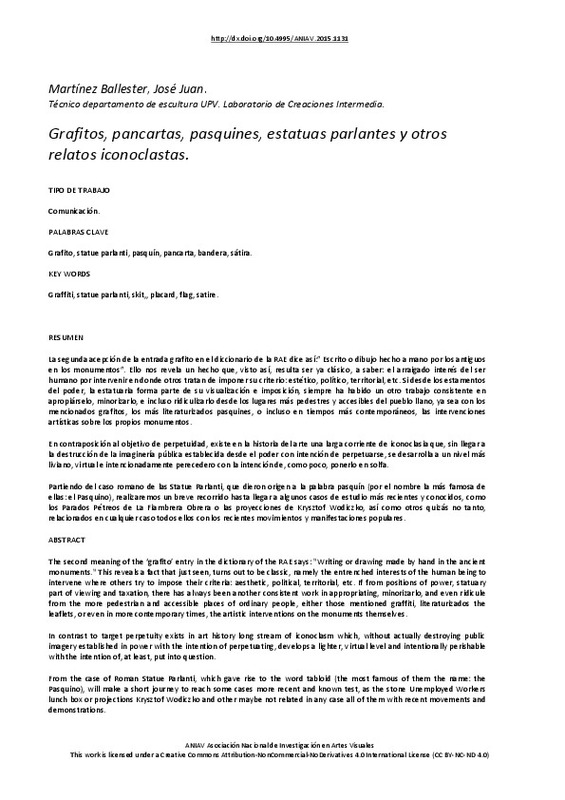JavaScript is disabled for your browser. Some features of this site may not work without it.
Buscar en RiuNet
Listar
Mi cuenta
Estadísticas
Ayuda RiuNet
Admin. UPV
Grafitos, pancartas, pasquines y otros relatos iconoclastas
Mostrar el registro sencillo del ítem
Ficheros en el ítem
| dc.contributor.author | Martínez Ballester, José Juan
|
es_ES |
| dc.date.accessioned | 2018-02-15T10:10:52Z | |
| dc.date.available | 2018-02-15T10:10:52Z | |
| dc.date.issued | 2015-11-26 | |
| dc.identifier.isbn | 9788490483411 | |
| dc.identifier.uri | http://hdl.handle.net/10251/97954 | |
| dc.description.abstract | [EN] The second meaning of the ‘grafito’ entry in the dictionary of the RAE says: "Writing or drawing made by hand in the ancient monuments." This reveals a fact that just seen, turns out to be classic, namely the entrenched interests of the human being to intervene where others try to impose their criteria: aesthetic, political, territorial, etc. If from positions of power, statuary part of viewing and taxation, there has always been another consistent work in appropriating, minorizarlo, and even ridicule from the more pedestrian and accessible places of ordinary people, either those mentioned graffiti, literaturizados the leaflets, or even in more contemporary times, the artistic interventions on the monuments themselves. In contrast to target perpetuity exists in art history long stream of iconoclasm which, without actually destroying public imagery established in power with the intention of perpetuating, develops a lighter, virtual level and intentionally perishable with the intention of, at least, put into question. From the case of Roman Statue Parlanti, which gave rise to the word tabloid (the most famous of them the name: the Pasquino), will make a short journey to reach some cases more recent and known test, as the stone Unemployed Workers lunch box or projections Krysztof Wodiczko and other maybe not related in any case all of them with recent movements and demonstrations. | es_ES |
| dc.description.abstract | [ES] La segunda acepción de la entrada grafito en el diccionario de la RAE dice así:” Escrito o dibujo hecho a mano por los antiguos en los monumentos”. Ello nos revela un hecho que, visto así, resulta ser ya clásico, a saber: el arraigado interés del ser humano por intervenir en donde otros tratan de imponer su criterio: estético, político, territorial, etc. Si desde los estamentos del poder, la estatuaria forma parte de su visualización e imposición, siempre ha habido un otro trabajo consistente en apropiárselo, minorizarlo, e incluso ridiculizarlo desde los lugares más pedestres y accesibles del pueblo llano, ya sea con los mencionados grafitos, los más literaturizados pasquines, o incluso en tiempos más contemporáneos, las intervenciones artísticas sobre los propios monumentos.En contraposición al objetivo de perpetuidad, existe en la historia del arte una larga corriente de iconoclasia que, sin llegar a la destrucción de la imaginería pública establecida desde el poder con intención de perpetuarse, se desarrolla a un nivel más liviano, virtual e intencionadamente perecedero con la intención de, como poco, ponerlo en solfa.Partiendo del caso romano de las Statue Parlanti, que dieron origen a la palabra pasquín (por el nombre la más famosa de ellas: el Pasquino), realizaremos un breve recorrido hasta llegar a algunos casos de estudio más recientes y conocidos, como los Parados Pétreos de La Fiambrera Obrera o las proyecciones de Krysztof Wodiczko, así como otros quizás no tanto, relacionados en cualquier caso todos ellos con los recientes movimientos y manifestaciones populares | es_ES |
| dc.format.extent | 6 | es_ES |
| dc.language | Español | es_ES |
| dc.publisher | Editorial Universitat Politècnica de València | es_ES |
| dc.relation.ispartof | II CONGRESO INTERNACIONAL DE INVESTIGACIÓN EN ARTE VISUALES | es_ES |
| dc.rights | Reconocimiento - No comercial - Sin obra derivada (by-nc-nd) | es_ES |
| dc.subject | Grafito | es_ES |
| dc.subject | Statue parlanti | es_ES |
| dc.subject | Pasquín | es_ES |
| dc.subject | Pancarta | es_ES |
| dc.subject | Bandera | es_ES |
| dc.subject | Sátira | es_ES |
| dc.title | Grafitos, pancartas, pasquines y otros relatos iconoclastas | es_ES |
| dc.type | Capítulo de libro | es_ES |
| dc.type | Comunicación en congreso | es_ES |
| dc.identifier.doi | 10.4995/ANIAV.2015.1131 | |
| dc.rights.accessRights | Abierto | es_ES |
| dc.contributor.affiliation | Universitat Politècnica de València. Departamento de Escultura - Departament d'Escultura | es_ES |
| dc.contributor.affiliation | Universitat Politècnica de València. Facultad de Bellas Artes - Facultat de Belles Arts | es_ES |
| dc.description.bibliographicCitation | Martínez Ballester, JJ. (2015). Grafitos, pancartas, pasquines y otros relatos iconoclastas. En II CONGRESO INTERNACIONAL DE INVESTIGACIÓN EN ARTE VISUALES. Editorial Universitat Politècnica de València. 473-478. https://doi.org/10.4995/ANIAV.2015.1131 | es_ES |
| dc.description.accrualMethod | OCS | es_ES |
| dc.relation.conferencename | II Congreso Internacional de Investigación en Artes Visuales. |< real | virtual >| ANIAV2015 | es_ES |
| dc.relation.conferencedate | July 09-10,2015 | es_ES |
| dc.relation.conferenceplace | Valencia, Spain | es_ES |
| dc.relation.publisherversion | http://ocs.editorial.upv.es/index.php/ANIAV/ANIAV2015/paper/view/1131 | es_ES |
| dc.description.upvformatpinicio | 473 | es_ES |
| dc.description.upvformatpfin | 478 | es_ES |
| dc.type.version | info:eu-repo/semantics/publishedVersion | es_ES |
| dc.relation.pasarela | OCS\1131 | es_ES |








